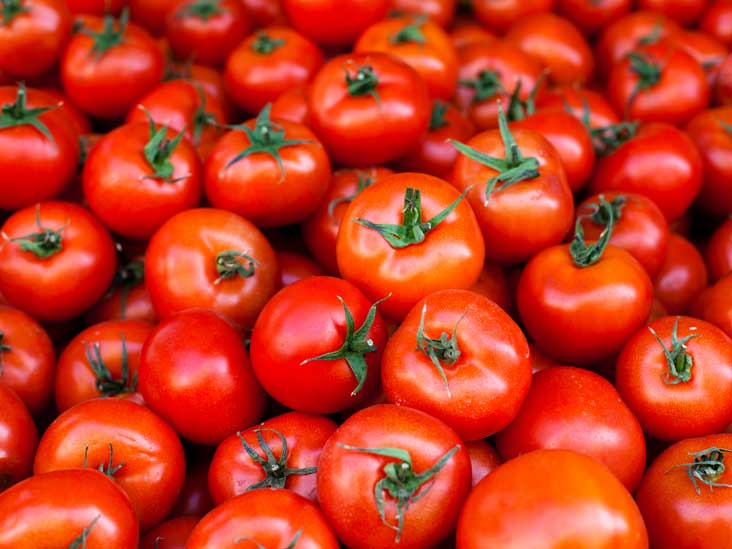
Tomato is considered both, a fruit and a vegetable and forms an integral part of cuisines across the globe, especially in the Mediterranean region. Daily consumption of tomatoes provides a great boost to the health, along with improving the flavor of food. You can find them in different foods like pasta, pizzas, ketchup, and various beverages. They are relatively easy to cultivate and grow very quickly, making them a great food source, which is a big reason why tomatoes are a staple food for many nations.
The scientific name of tomatoes is Solanum lycopersicum and they are believed to be native to Mexico. However, the Spanish colonization of America and Central America caused tomato cultivation to spread. They are an annual nightshade plant and grow in clusters of small to moderately sized, round red fruits. They have soft, pinkish red flesh and a number of seeds, as well as a slightly sweet taste. They are considered both, vegetables and fruits and weigh approximately 4 ounces.
Nowadays, tomatoes are grown in countries all over the world and there are thousands of cultivars and varieties that can provide you with unique health benefits.
Tomatoes can be likened to a power plant, because it has great benefits and benefits to human health. Tomatoes are rich in vitamin A, C, C, vitamin B6, potassium, folate, thiamine, magnesium, niacin, copper and phosphorus, all of which are essential for the human body. One of the best benefits of tomatoes is that cholesterol, saturated fat, sodium and calories are very low. You can use it in sandwiches, salads, smoothies and soups. The following are also the benefits of tomatoes.
Tomatoes contain plenty of potassium. It’s also interesting to know that most of us are suffering from potassium deficiency. A glass of tomato juice contains 543 mg of potassium and ½ cup tomato sauce contains 454 mg of potassium. So try to eat tomatoes or sauces daily.
Tomatoes have the characteristics that when combined with other beneficial fats, such as avocados or olive oil, 2 to 15 times higher is the absorption of cyanotic carcinogens in tomato.
Tomatoes aid in maintaining healthy teeth, bones, hair, and skin. Topical application of tomato juice is even known to cure severe sunburns. Daily consumption protects the skin against UV-induced erythema.They rank high in the preparation of anti-aging products. Furthermore, an antiperspirant composition for the treatment of hyperhidrosis (excessive sweating) containing tomato as one of the ingredients was patented.
Tomato Selection and Storage
When selecting tomatoes at the market, use your nose. Smell the blossom (not stem) end. The most flavorful ones will have a rich tomato aroma.
Select tomatoes that are round, full, and feel heavy for their size, with no bruises or blemishes. The skin should be taut, not shriveled. Store fresh ripe tomatoes in a cool, dark place, stem-side down, and use within a few days.
Refrigeration is the enemy of the tomato as it nullifies flavor and turns the flesh mealy. The culprit is a compound called Z-3 hexenel, which accounts for the tomato’s scent and taste. The development process which turns tomato’s linolenic acid to the Z-3 that makes our mouth and nose sing is hindered by the cold. If you must refrigerate a tomato, take it out about an hour before using it to let it return to room temperature to revive any lurking Z-3.
When wintering your garden, you can salvage some of those tomatoes that haven’t yet ripened by wrapping them in newspaper and storing in a cool area between 10 and 25 C for two to four weeks.
Store them no more than two deep and check them often to use the ones that have begun to ripen.
Specifications:
Tomato HS Code: 07020000
| Product | Size | Packing Type | Growing Region | Comments |
| Tomatoes | 70 – 130 g | 2 rows 7.0 kg Carton | Jiroft, Isfahan, IRAN | Palletizing and different packing type is available |

